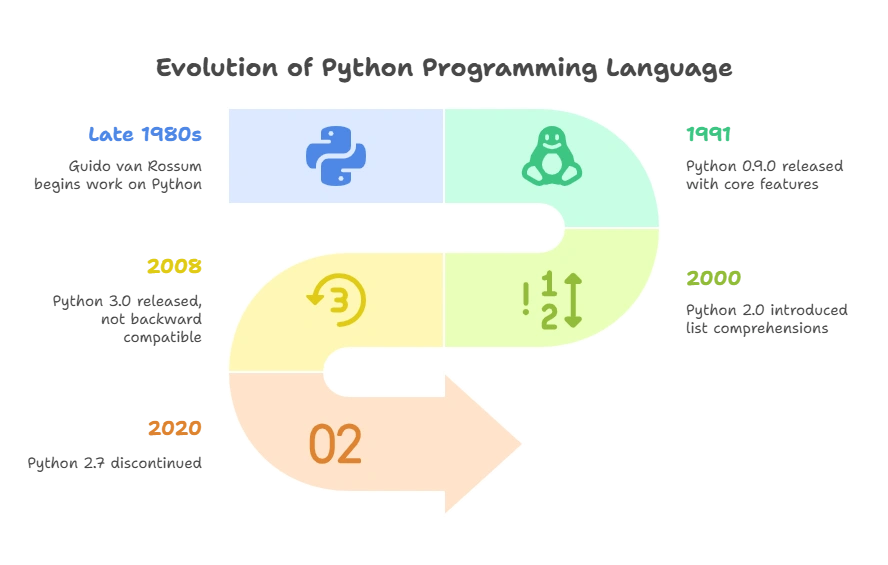What is Python?
Python is a high-level, interpreted, and general-purpose programming language. Its design philosophy emphasizes code readability through the use of significant indentation. Python's syntax allows programmers to express concepts in fewer lines of code than would be possible in languages such as C++ or Java. The language provides constructs that enable clear programming on both small and large scales.
Python supports multiple programming paradigms, including procedural, object-oriented, and functional programming. It has a dynamic type system and automatic memory management, making it easy to learn and use.
Origin and History
Python was created by Guido van Rossum and first released in 1991. Van Rossum started working on Python in the late 1980s as a successor to the ABC language, which was developed at CWI in the Netherlands. He aimed to correct some of ABC’s problems while retaining its positive features. Python’s name is derived from the British comedy series “Monty Python’s Flying Circus,” which van Rossum enjoyed.
History of Python
- Late 1980s: Guido van Rossum began work on Python at CWI.
- 1991: The first version, Python 0.9.0, was released. This version included features like exception handling, functions, and the core data types of list, dict, str, and more.
- 2000: Python 2.0 was released, introducing new features like list comprehensions and a garbage collection system capable of collecting reference cycles.
- 2008: Python 3.0 was released to fix inconsistencies and remove redundant constructs. However, it was not backward compatible with Python 2.x.
- 2020: Python 2.7, the last release of the Python 2.x series, was officially discontinued.

Features
- Simple and Easy to Learn: Python’s syntax is clear and intuitive, making it accessible for beginners.
- Readability: Code readability is a core feature of Python, allowing developers to write clear, logical code.
- Interpreted Language: Python code is executed line-by-line, which makes debugging easier.
- Dynamically Typed: Variable types are determined at runtime, allowing for flexibility in coding.
- Comprehensive Standard Library: Python comes with a rich standard library, providing modules and functions for various tasks.
- Cross-Platform: Python can run on various operating systems, including Windows, macOS, and Linux.
- Extensible and Embeddable: Python can be extended with modules written in C or C++ and can be embedded within C/C++ programs.
- Community and Ecosystem: Python has a large and active community, contributing to a wide range of libraries and frameworks.
Advantages
- Ease of Use and Learning: Python’s straightforward syntax and readability make it an ideal language for beginners and a quick tool for experienced developers.
- Productivity: Python enhances productivity by allowing developers to focus on solving problems rather than dealing with complex syntax.
- Versatility: Python is used in various domains, including web development, data analysis, artificial intelligence, scientific computing, and automation.
- Strong Community Support: The extensive community support means a wealth of resources, tutorials, and third-party modules are available.
Drawbacks
- Performance: Python is generally slower than compiled languages like C or C++ due to its interpreted nature.
- Memory Consumption: Python can consume more memory, making it less suitable for memory-intensive applications.
- Mobile Development: Python is not commonly used for mobile app development, where languages like Java, Swift, or Kotlin are more prevalent.
- Global Interpreter Lock (GIL): The GIL can be a bottleneck in CPU-bound and multithreaded programs, limiting performance in certain scenarios.
Python continues to grow in popularity due to its ease of use, versatility, and strong community support, making it a powerful tool for both beginners and experienced developers alike. Happy coding !❤️
